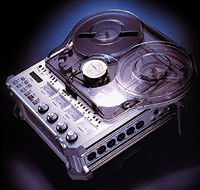
#NAGRA REEL TO REEL SERIES#
Kudelski SA also produced a series of miniaturised reel-to-reel recorders using a special tape (width 3.81 millimetres (150 thou)), slightly larger than the conventional 1/8" cassette tape. These machines were used by intelligence services of several countries and logging service of radio stations.
#NAGRA REEL TO REEL CODE#
When equipped with the accessory RCHS, Time Code Reader Searcher, the machine allows high speed search of a particular sequence when its time code had been entered by the keyboard or from its memory. The machine is equipped with an automatic start recording device actuated by the input signal and, at the tape end, allows automatic connection to another machine that begins recording on a new tape without loss of signal. It is a reel to reel 1/4" tape recorder designed for automatic long recording using the four standard tape speeds.

NAGRA TRVR - A rare stereo machine designed with the 19" rack format.produced a studio recorder called the Nagra T-Audio, designed mainly for use in telecines for transferring dailies. In addition to these field recorders, Kudelski S.A. NAGRA E - A simple, single-speed (7.5ips), mono recorder aimed at radio reporters was introduced in 1976.Supply and take up spools have their own motors. The IS is the only model derived from the original Nagra III to use three motors for tape transport. Special versions of the IS called ISN and ISS could play back the 3,81 mm wide tape used with Nagra SN recorders. Focus was on simple operation and lower weight than the IV/4-series recorders. The Nagra IS was a small-bodied recorder, to be used in both film- and broadcast applications. Nagra IS - In 1974 the Nagra IS (nicknamed Idioten-Sicher or "idiot proof" by its users) was introduced.Pots are replaced with switches to set gain in precise steps, no limiters, and when present, the microphone inputs are for high-voltage unbalanced instrumentation mics rather than low impedance balanced with T-power and phantom. Nagra IV-SJ - Stereo Nagra for instrumentation and logging.

#NAGRA REEL TO REEL UPGRADE#
In the 1980s one could upgrade a 4.2 to record SMPTE timecode. Nagra 4.2 - Same as the IV-L, but added powering for microphones and built-in equalizers.The unreliable head mounts were redesigned three times with the final design being designated the Nagra 4.2 Nagra IV-L - Monaural, Neopilot sync, featuring two microphone inputs and a built-in audio limiter.This was a monaural recorder, with the "NP" denoting the Neopilot sync. Nagra III NP - The first Nagra usable for film work, appearing in 1958.NAGRA II CI - The second generation fitted with printed circuit boards replacing chassis wiring, appearing in 1955.Later the Nagra II was improved to the Nagra II b and in 1955, to the Nagra II c (a Nagra II with some improvements in electronics and using the first Nagra printed circuit). In 1953, in a new facility, Nagra began the production of the Nagra II (a Nagra I with the option to have an external modulometer (a type of VU meter) in the sidewall. NAGRA II - The first production model, miniature tubes equipped, clockwork motor, which appeared in 1953.NAGRA I - The very first prototype with clockwork motor and miniature tubes, appearing in 1951.Nagra recorders are identified by a number that indicates their technological generation and features: This was commonly known as double system sound. After the introduction of crystal sync, the tape recorder could operate separately from the camera, each having a separate accurate clock guaranteed to stay in sync with the other, allowing the sound recordist significantly more freedom of movement.

Originally, a physical sync lead tethered the Nagra recorder to the camera (putting a pulse from the camera onto the tape), to ensure any fluctuations in the tape were accounted for. Nagra-brand tape recorders were the de facto standard sound recording systems for motion picture and (non-video) single-camera television production from the 1960s until the 1990s. Nagra means " will record" in Polish, Kudelski's mother language. The machines were initially designed by Polish inventor Stefan Kudelski, and his company won numerous technical awards for their precision and reliability.


 0 kommentar(er)
0 kommentar(er)
